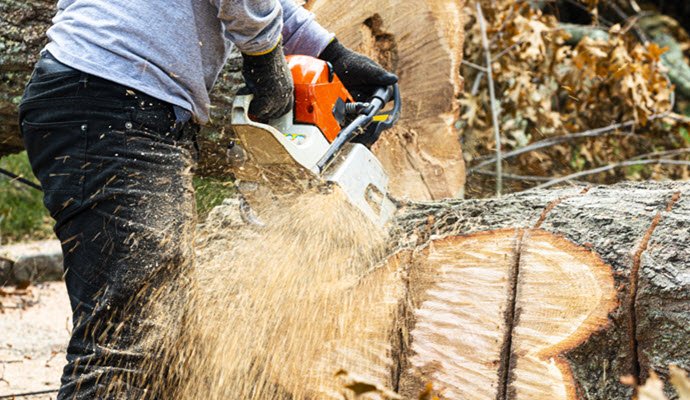Tree Removal - Toolbox & Process
For each section of tree, the arborist performs selective removal of limbs, branches and other debris to reduce the tree's weight and to remove any protrusion that could pose a hazard during the removal of the trunk. This pruning and limbing process also helps improve the arborist’s access to the main trunk, which is needed to make the sectional cuts during tree removal.
Arborists use a variety of tools to cut limbs and branches, the most obvious being the chainsaw. The chainsaw is the arborist’s primary cutting tool. However, professional arborists aren’t just using run-of-the-mill chainsaws—those simply won’t cut it (pun intended) for tree removal. Rather, your arborist uses a professional-grade chainsaw that possesses higher horsepower and torque, specialized bar lengths and lightweight construction that provides the maneuverability required for tree removal tasks. We’re talking forestry-pedigree saws that have the stamina to power through dense wood, hour after hour. A variation of chainsaw used by your arborist is the pole saw. This consists of a chainsaw attached to a long pole, enabling the arborist to reach high branches safely without the need for a lift bucket. Arborists may also use a handsaw to cut smaller branches or make cuts in areas where chainsaws may not be suitable. Handsaws provide greater control and allow arborists to work with more precision.
Bring it on down
Once the arborist has pruned, limbed and made the required cuts to prepare a section of tree for removal, it’s time to relocate the section to the ground safely. Sometimes, the arborist accomplishes this by guiding the tree section to fall into a predetermined fall zone on the ground. In other tree removal scenarios, however, your arborist uses a specialized rigging system, sometimes called a block and tackle. A block and tackle is essentially a system of pulleys and ropes that gives the arborist a mechanical advantage. The block and tackle distribute the weight of large tree sections or limbs across the entire system, allowing the arborist to control the tree section’s descent to the ground, thereby preventing damage to property or surroundings during tree removal.
Chipping away to leave a tidy worksite
Once the tree has been taken apart, all those pieces need to go somewhere in order to leave the area clean. Again, your arborist calls on the professional-grade chainsaw to cut tree trunk sections into smaller pieces that can be transported away more easily. For smaller trunk and limb pieces, your arborist uses a woodchipper. The key parts of this machine are the combustion engine that powers sharp steel blades capable of reducing solid wood—such as limbs, branches and even trunk pieces—into much smaller wood chips following the tree removal. The chipped material can be used for mulching or easily transported off-site. Woodchippers are an essential tool for efficient debris removal.
And there you have it, a brief look into the arborist’s toolbox for tree removal. Arborists in Edmonton combine their skills and expertise with these tools and equipment to ensure the proper care, maintenance, and removal of trees while prioritizing safety for themselves and the surrounding environment.
It’s essential to contact an ISA Certified Arborist or professional tree service company for a tree removal assessment and advice on the best course of action for your trees. By removing hazardous or unwanted trees promptly, we can help keep our communities safe, healthy, and beautiful. Reach out to us today for a free estimate.


